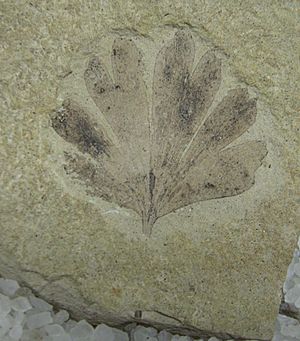Ginkgo dissecta facts for kids
Quick facts for kids Ginkgo dissectaTemporal range: Early Eocene
|
|
|---|---|
 |
|
| G. dissecta leaf | |
| Scientific classification | |
| Genus: |
Ginkgo
|
| Species: |
dissecta
|
Ginkgo dissecta was an ancient type of ginkgo tree that is now extinct. It belonged to the same plant family as the modern ginkgo tree you might see today. Scientists have learned about this tree from fossil leaves found in rocks. These fossils were discovered in parts of British Columbia, Canada, and Washington, USA. Ginkgo dissecta is one of two ginkgo species found in these areas.
Discovering the Ancient Ginkgo
Scientists found fossils of Ginkgo dissecta in four different rock layers. The main place where this species was identified is called the McAbee Fossil Beds. This site is near Cache Creek, British Columbia, and its rocks are part of the Tranquille Formation.
Fossils of G. dissecta were also found in the Klondike Mountain Formation. These rocks are located around the town of Republic, in Ferry County, Washington. Other discoveries happened near Princeton, British Columbia, and at a place called the "Falkland site" near Falkland, British Columbia. This Falkland site is also part of the Tranquille Formation.
The first important fossils used to describe G. dissecta were two leaf fossils. They came from the McAbee Fossil Beds. These special fossils are kept in the paleobotanical collections at Western Washington University. Many other fossils from McAbee and Princeton are also stored there.
A scientist named George Mustoe from Western Washington University studied these fossils. He published his findings about G. dissecta in 2002. His work appeared in a science paper called the Canadian Journal of Botany. The name dissecta was chosen for this species.
What Did Ginkgo dissecta Look Like?
The leaves of G. dissecta were about 50 to 80 mm (2.0 to 3.1 in) wide. Their stems, called petioles, could be up to 40 mm (1.6 in) long.
Unlike the modern Ginkgo biloba leaf, which usually has two main parts, G. dissecta leaves had four main parts, or lobes. These lobes were separated by deep cuts that went almost all the way to the leaf's base. Sometimes, there were even smaller cuts higher up on the lobes.
The way the veins spread out in G. dissecta leaves was also unique. Many veins started at the base of the leaf and then branched out. In contrast, the modern G. biloba has veins that all branch from a single vein along the edge of the leaf.
G. dissecta had fewer veins per centimeter than G. biloba. It had about 12–14 veins per centimeter, while G. biloba usually has 16–17.
This ancient ginkgo looked a bit like older fossil species such as G. digitata and G. huttonii. However, those older species, found in Jurassic rocks, typically had six lobes instead of four. They also had tiny hairs, called trichomes, on the underside of their leaves, which G. dissecta did not have.

